Matcha green tea ice cream: what is it & how does it taste?
Matcha green tea ice cream is a cool, delicious treat enjoyed in Japan year-round, but you’ve probably seen it somewhere closer to home. The green color can be off-putting, but the flavor is quite pleasant.
Matcha green tea ice cream is a Japanese ice cream made with dairy and green tea powder, also called matcha which has a grassy flavor with a hint of sweetness. It’s not made of green tea leaves. Rather, the matcha powder gives this ice cream its unique flavor and color.
It’s an acquired taste, but one that is well worth acquiring! So let’s look at how it differs from other types of ice cream.
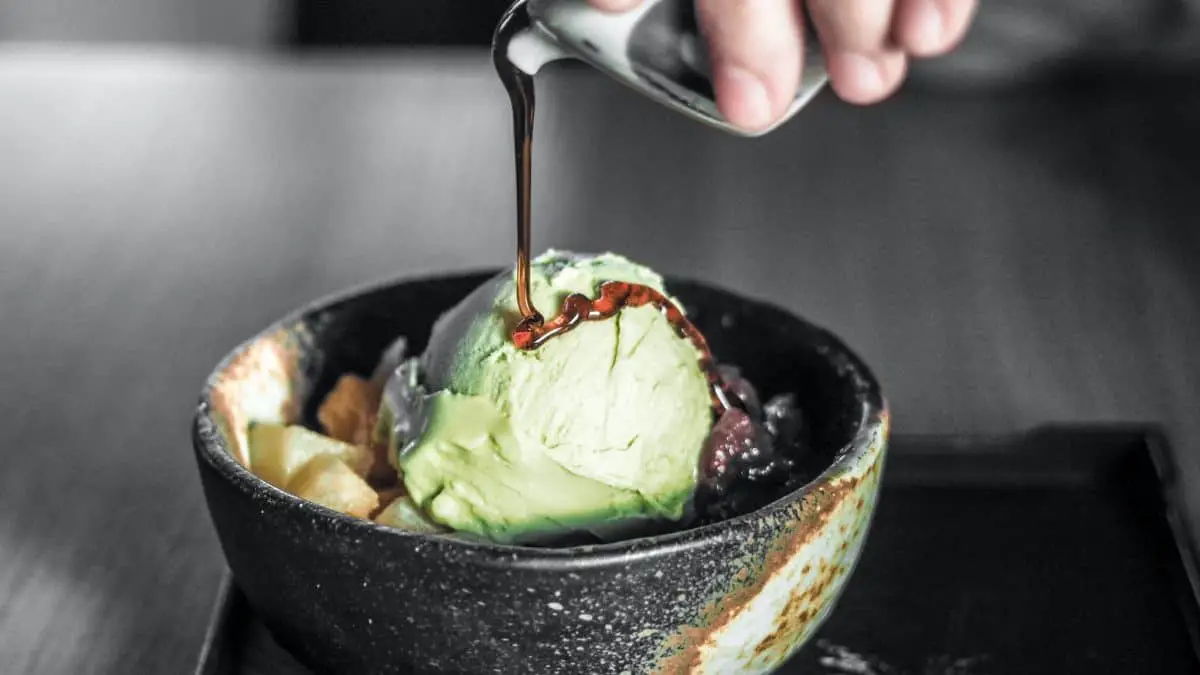

Check out our new cookbook
Bitemybun's family recipes with complete meal planner and recipe guide.
Try it out for free with Kindle Unlimited:
Read for freeIn this post we'll cover:
- 1 What is matcha green tea ice cream?
- 2 Japan and green tea: what’s the connection?
- 3 What is matcha powder?
- 4 What does Matcha ice cream taste like?
- 5 Does green tea ice cream have green tea in it?
- 6 Does Matcha ice cream come in flavors?
- 7 Is Matcha ice cream good for you?
- 8 What is the difference between Matcha and other forms of green tea?
- 9 What do you eat with Matcha ice cream?
- 10 Does Matcha ice cream contain caffeine?
- 11 What type of Matcha is recommended for making ice cream?
- 12 What are the best brands of culinary grade Matcha?
- 13 What are the best brands of Matcha ice cream?
- 14 FAQs
- 14.1 Is Matcha ice cream vegan?
- 14.2 Is Matcha ice cream gluten-free?
- 14.3 Is Matcha ice cream paleo?
- 14.4 Is Matcha ice cream Keto?
- 14.5 What is Mochi ice cream?
- 14.6 Does matcha green tea ice cream have dairy?
- 14.7 What is tea-flavored ice cream?
- 14.8 Is culinary grade matcha good for you?
- 14.9 Can you use culinary matcha for tea?
- 15 Takeaway
What is matcha green tea ice cream?
Matcha ice cream is also called matcha ice or 抹茶アイス (Matcha aisu) in Japanese.
Matcha, a grassy, earthy green tea powder, is used to make green tea ice cream, a traditional Japanese delicacy.
It’s a form of ice cream just like Western ice cream, but the ice cream recipe is made with matcha powder and generally has a more intense green tea flavor.
The matcha taste is a bit grassy and slightly sweet. This powder provides a healthy dose of antioxidants, making this a healthier choice for an indulgent treat.
The well-known delicacy combines cooled cream’s sweetness with the herbal flavor of matcha.
It is a very popular flavor in Japan and can be found in most ice cream parlors.
Matcha ice cream is made with an ice cream machine like other ice cream recipes.
What’s the origin of matcha ice cream?
Matcha green tea ice cream is a Japanese invention.
But even before green tea ice cream, green tea shaved ice, or Uji Kintoki, was well-known and well-liked in Japan.
If you spend any amount of time in Japan, you will notice that many of their sweets come in green tea flavors.
It is rumored that this first began when green tea ice cream was presented to the Emperor about 100 years ago.
During the Meiji period (1868-1912), matcha-flavored ice cream was served in the shape of Mt Fuji to the nobility.
Kyoto is well-known for the Inari Saryo ice cream shop, which is located on the hike to Mt Inari. It’s believed the matcha ice cream craze started there.
However, it wasn’t until much more recently, in fact only about 20 years ago, that candy manufacturers started incorporating green tea into their products.
In addition to matcha ice cream, you can also enjoy treats like the Uji-Matcha flavored Choko-Ball which are ball shaped cookies coated with Matcha chocolate.
Alfort Premium is another popular treat that features cocoa cookies combined with Matcha chocolate.
Popular brands like Kit Kat and Pocky have also combined green tea elements into their Japanese products.
Learn more about the wonderful world of Japanese chocolate and cacao here
In 1996, Häagen-Dazs Japan began manufacturing the famous green tea ice cream and sold it in grocery stores across Japan.
To this day, it’s one of the most popular flavors.
The ice cream flavor made its way to America many years ago.
An ice cream shop owner Sam Emanuele made green tea matcha ice cream a staple of his New York ice cream parlor.
Japan and green tea: what’s the connection?
Today green tea ice cream is becoming more popular, and we can often find it on grocery store shelves in the United States.
But there are still many Americans that find it an unlikely treat. And this is not without reason.
Green tea has a slightly bitter taste, and therefore, it might not be the first thing to come to mind when people think of ice cream flavors.
However, if you consider the green tea and Japanese connection, it seems inevitable for matcha powder to eventually be incorporated into their cultural sweet treats.
Tea was introduced to Japan in the 9th century, and it quickly became an integral part of cultural life.
Green tea has become a favorite due to the many health benefits it offers, so it makes sense that this is a drink enjoyed by many Japanese people during breakfast and throughout the day.
In fact, green tea is so popular in Japan that the country has devoted an entire day to green tea.
Green Tea Day is on the 88th day after the first day of spring (typically May 1 or 2).
Green tea is very vulnerable to frost. Therefore, harvesting should take place as soon as there is no sign of frost.
The 88th day after the beginning of spring is typically frost free.
What’s more, the leaves picked at this time of year are usually the freshest and believed to be good luck.
Matcha powder is made from these young, fresh leaves.
So it only makes sense that green tea would also be used in one of Japan’s favorite ice cream flavors.
With Americans’ interest in all things healthy, the ice cream flavor took root and is now enjoyed by many year-round.
What is matcha powder?
Matcha powder is a type of green tea made from the leaves of the Camellia sinensis plant.
These leaves are shade-grown before harvest, which increases the chlorophyll content and results in a vibrant green color.
The leaves are then ground into a fine powder using a stone mill. This powder is the key ingredient in making matcha green tea ice cream.
Since the powder is very fine, it doesn’t affect the ice cream mixture and texture.
Where does matcha come from?
Matcha comes from Japan and China.
It is a very fine powder made from grinding whole green tea leaves.
The powder is used to make a bright green tea infusion which is popular in many parts of Asia.
Although matcha is not unique to Japan, the country does produce some of the finest grades of matcha in the world.
Matcha vs green tea powder
When purchasing matcha powder from the grocery store, you must be cautious. Green tea powder and matcha powder are produced differently and have quite distinct flavors.
Compared to conventional green tea powder, matcha powder has a tendency to taste sweeter. This is due to the fact that it was picked and processed into powder very differently from regular green tea powder.
However, when it comes to ice cream, these powders are used interchangeably in most cases.
The distinct taste of matcha powder will be diluted when mixed with milk and other ingredients, so it won’t make a significant difference in the flavor of the ice cream recipe.
Greener than regular green tea, matcha tea powder has a brighter hue. Green tea feels gritty, like crushed-up leaves, but it is a very fine powder that resembles baking powder.
The best green tea leaves are often hand-harvested into matcha powder, which is then stone ground.
Green tea leaves are cultivated in the sunshine, whereas high-quality matcha tea leaves are grown in dark locations.
The quality, flavor, and nutritional value of matcha depend heavily on the shade-growing technique.
The leaves develop thinner and broader, making them simpler to grind into a fine powder because they do not absorb as much sunlight as regular green tea leaves.
In addition, the matcha plant produces more chlorophyll, the pigment that absorbs sunlight and gives matcha its well-known vivid green hue.
The majority of supermarkets carry a variety of matcha powder brands.
You must be cautious and pick a company that sells genuine matcha that has been stone ground rather than just green tea leaves that have been powdered.
Real matcha powder generally tastes far better in desserts and beverages.
What does Matcha ice cream taste like?
This tasty delicacy should have the perfect harmony of earthy, sweet, and mildly bitter flavors. The matcha flavor is best described as “grassy” or herbal, but it’s very refreshing.
Matcha has a powerful flavor profile because it is significantly more concentrated than conventional green tea.
Matcha ice cream is not as creamy as other types of ice cream. The sugar and cream give it a sweet taste, but this is countered by the slightly bitter flavor of the matcha.
Overall, the green tea matcha ice cream is well-balanced but less sweet compared to traditional ice cream.
If you would like to give it a try, check out this easy to follow match green tea ice cream recipe:
Does green tea ice cream have green tea in it?
No, this ice cream does not have any green tea leaves in it. Matcha powder is used to flavor the ice cream and give it its distinctive color.
Therefore, there is no green tea in green tea ice cream.
Does Matcha ice cream come in flavors?
Even though matcha is its own flavor, it can be flavored with different fruits.
For instance, there are strawberry, banana, and raspberry-flavored matcha ice creams.
To achieve this mixture, the fruit is usually mashed with a food processor and then added to the ice cream.
This takes away from the intensity of the matcha powder taste.
Is Matcha ice cream good for you?
As far as desserts go, matcha is pretty healthy.
It is made with simple, all-natural ingredients, and green tea is known for providing several health benefits.
An authentic ice cream recipe doesn’t contain too many additives, so it’s quite healthy.
Homemade matcha ice cream is even healthier because there are no additives and preservatives.
It is packed with antioxidants, so it reduces the risk of heart disease and cancer. It can also promote weight loss.
However, the ice cream does have a considerable amount of sugar, and a half and half is a mixture of whole milk and heavy cream that can be quite fattening.
Therefore, like all desserts, you will want to eat matcha ice cream in moderation.
If you are really set on enjoying a healthy dessert, you can substitute the half and half with almond and coconut milk and add honey instead of sugar.
This will make a paleo-friendly, lower fat, and all-around healthy dessert that can be enjoyed more often.
What is the difference between Matcha and other forms of green tea?
Matcha and green tea both come from the same plant, the camellia sinesis plant.
However, matcha is grown differently than regular green tea.
Matcha tea bushes are shielded from sunlight 20 -30 days before harvest.
The shade increases the plant’s chlorophyll levels which turns the leaves a darker shade of green and increases the production of amino acids.
Once the plant is harvested, the stems and veins are removed from the leaves, and they are ground into matcha powder.
Because the whole leaf is ingested, people can benefit from the added caffeine and antioxidants.
What do you eat with Matcha ice cream?
Because matcha ice cream has an unusual flavor, unlike most ice creams, it may not taste great with chocolate sauce, caramel, or whipped cream.
However, you can add toppings like nuts and berries. Ginger, mint and white milk, and dark chocolate candies will also complement the flavor well.
It’s best to keep it simple when it comes to pairing green tea ice cream with toppings. Too many flavors will overwhelm the delicate taste of matcha.
If you want to get really creative, you can try making green tea marshmallows or meringues to top your ice cream.
Or, you could make a green tea milkshake by blending matcha powder, milk, and ice cream together.
This is a great way to enjoy the flavor of matcha without the hassle of making your own ice cream.
Does Matcha ice cream contain caffeine?
Yes. As mentioned earlier, matcha has high levels of caffeine, higher than those found in regular green tea.
Eating it in ice cream form does not reduce the caffeine content.
What type of Matcha is recommended for making ice cream?
When considering the types of matcha, you can choose between ceremonial, latte-grade, and culinary grade.
Matcha powder is typically sold in two to four different varieties, each with a different quality.
The nutritional value, flavor, method of harvesting, and cost of the matcha will all vary depending on its grade.
Ceremonial grade
This matcha is the highest quality and most expensive. It is made from the youngest leaves and has a bright green color with a slightly sweet taste.
Its flavor is described as very grassy and silky. It’s best for lattes and tea, and it isn’t really used for making dessert cuisine.
Latte grade
This type of matcha is smooth and a little grassy. It is used for desserts and is great for lattes.
The color is a deep green, and it has a slightly sweet taste. It isn’t as expensive as ceremonial grade matcha, but it is still of good quality.
Culinary grade
This matcha is the least expensive and has a more bitter flavor than the others. Culinary grade tea is made with slightly older leaves. The flavor is bitter and more robust, and the color is not as vibrant.
But since it’s a bit cheaper, most manufacturers use culinary-grade matcha in the ice cream recipe.
The most expensive matcha is ceremonial grade, and the cheapest is culinary grade.
You can use any grade of matcha, depending on your budget, but for this recipe for green tea ice cream, I suggest latte or culinary-quality matcha.
Culinary grade is best for cooking, and it will therefore be the best choice for making matcha ice cream.
What are the best brands of culinary grade Matcha?
Great matcha ice cream starts with great matcha tea.
If you are looking for a great matcha tea product, here are a few brands that are recommended.
Jade Leaf Culinary Grade Matcha
This tea was sourced from organic Japanese farms and shade-grown. It is vegan and gluten-free, and it’s a great source of antioxidants.
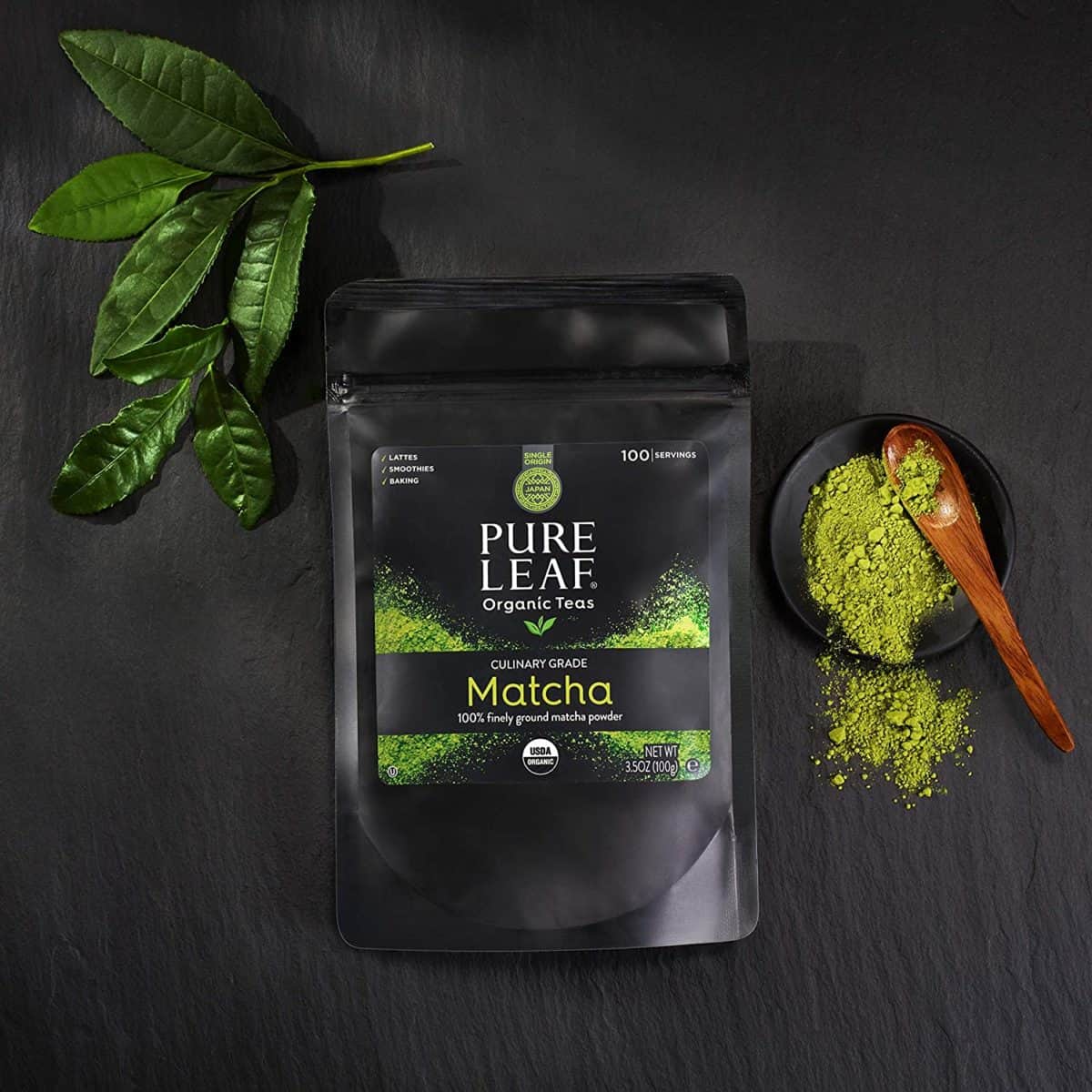
Aprika Life Premium Culinary Grade Matcha
This tea was grown in Japan with great care and pride.
It is 100% organic, and it has a smooth taste that is never bitter. It boosts energy, and it’s rich in antioxidants.
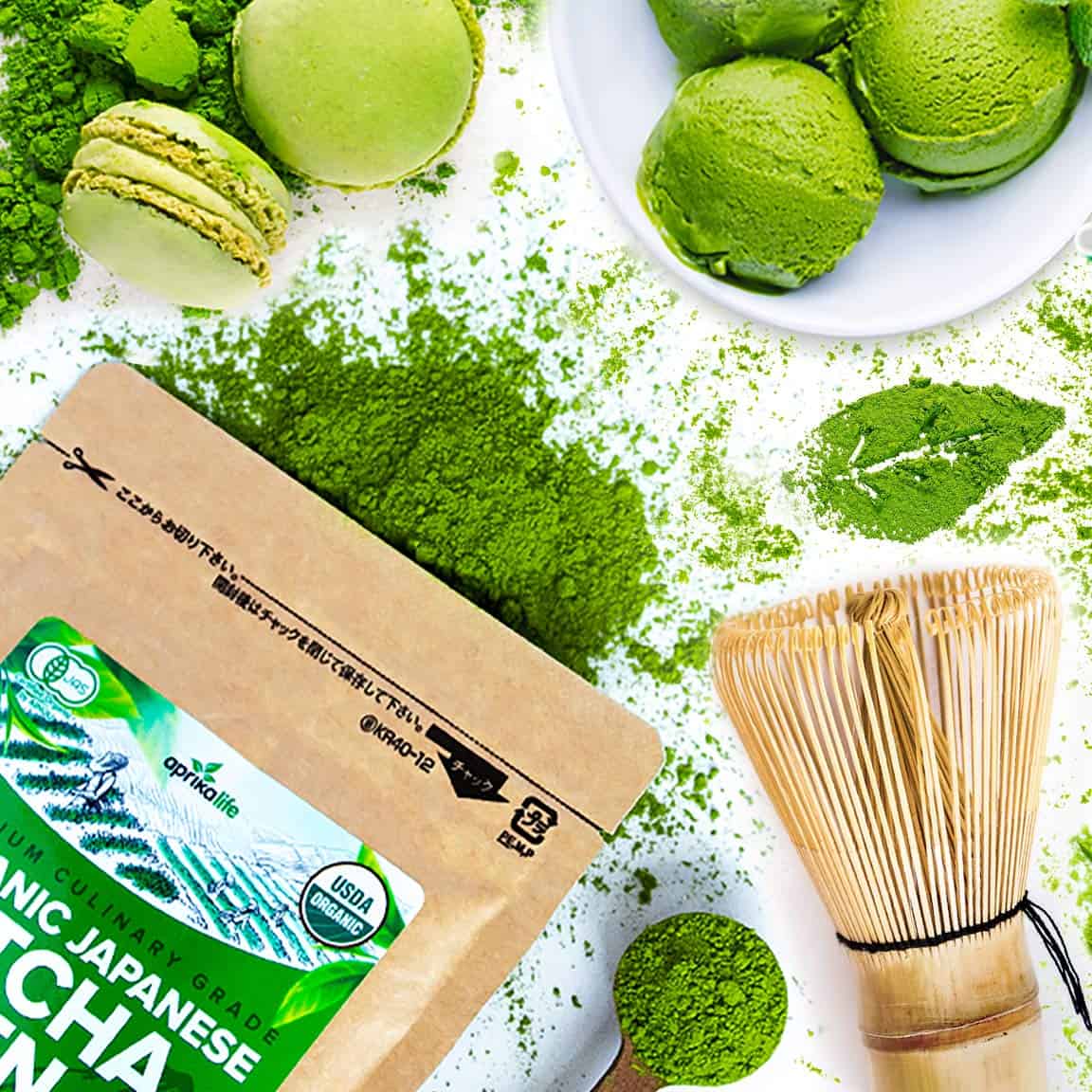
Pantenger Fine Culinary Grade Matcha
This tea was grown in Kagoshima Prefecture on a ninth-generation family-owned estate. It is shade grown and hand-picked.
It has a vibrant color and a smooth taste. It is packaged in air-tight tins to protect the tea from oxidation.
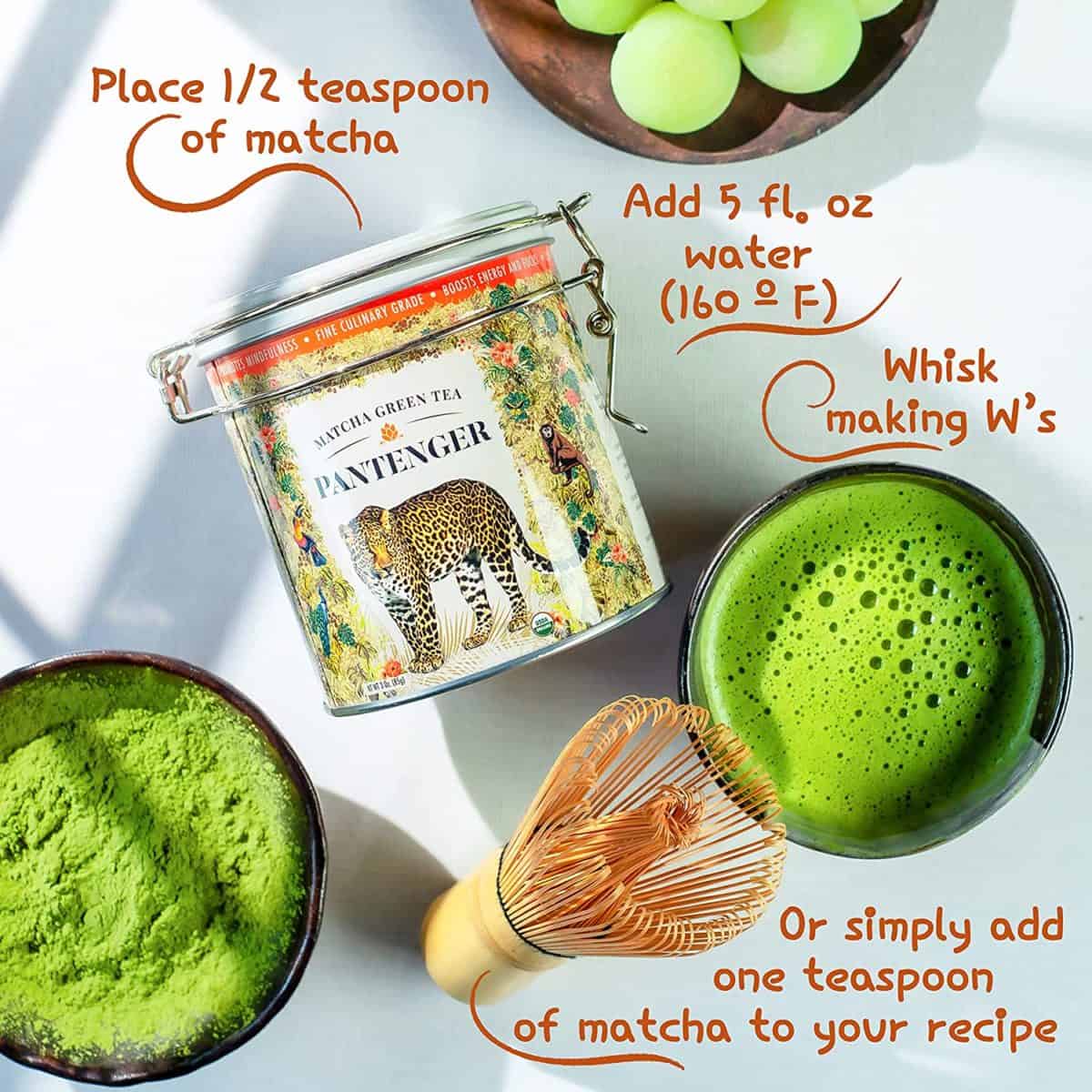
Kenko Culinary Grade Matcha
Kenko tea is ordered in small batches and ground fresh. It is then put in an airtight package to preserve the freshness.
It is shade grown, hand-picked, organic, and non-GMO. It has a vibrant color and a terrific taste and aroma.
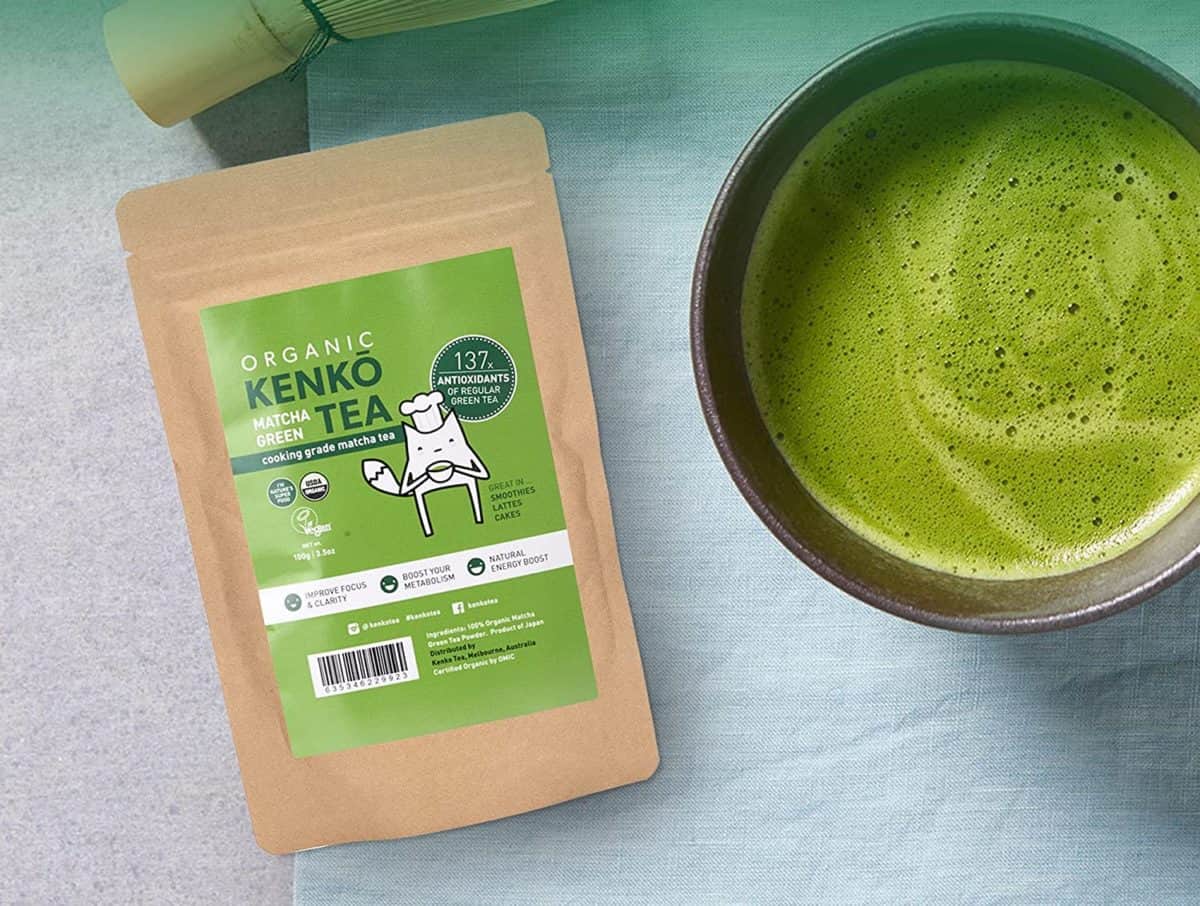
Match Moon Culinary Grade Matcha
This shade-grown tea is a great source of antioxidants and phytonutrients. It is organic, gluten-free, vegan, and keto and paleo-friendly.
This matcha powder has an unsweetened, slightly bitter taste that lets you know it’s the good stuff.
It is rich in nutrients, and it is recommended for boosting energy without the caffeine crash.
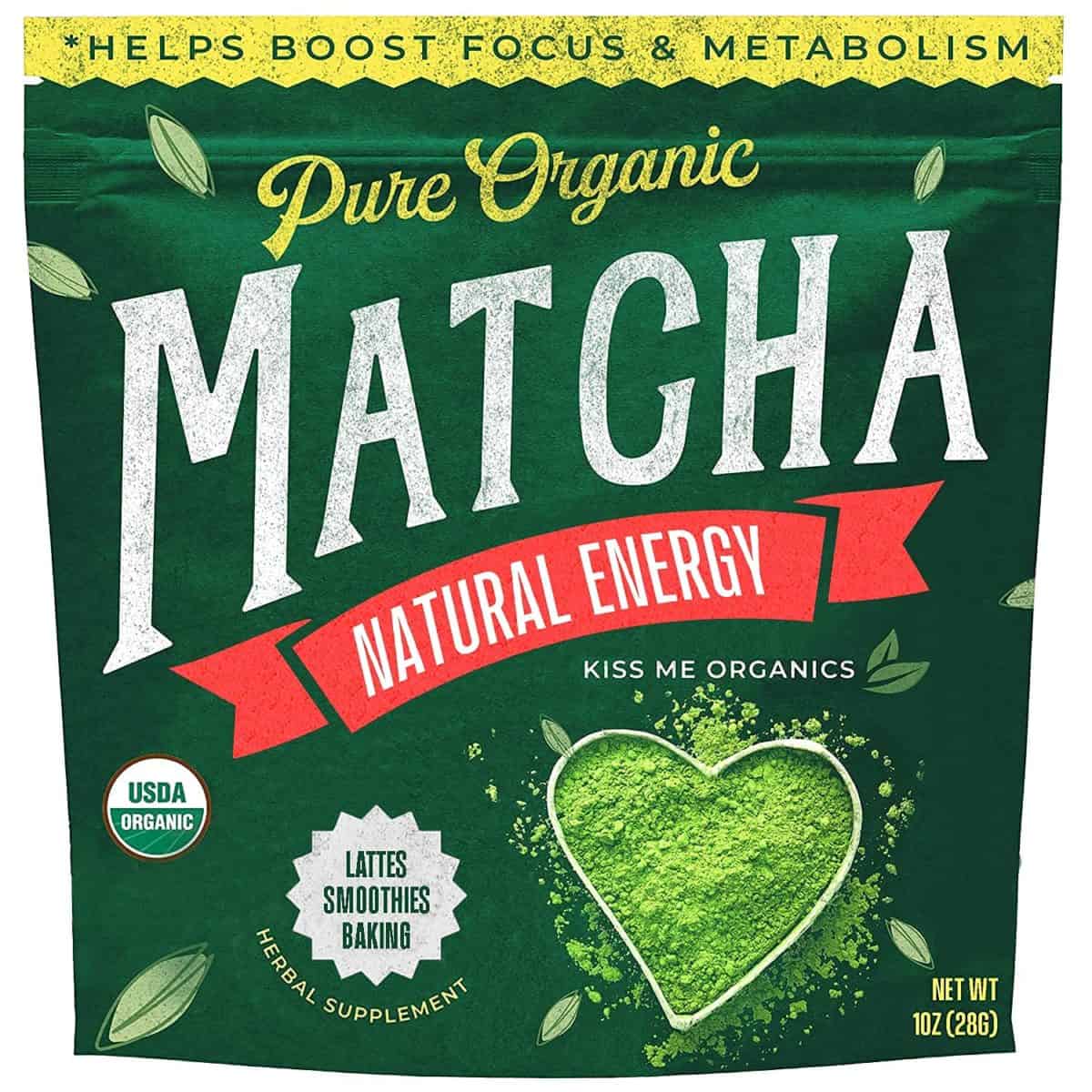
What are the best brands of Matcha ice cream?
Of course, not all of us will want to make matcha ice cream. Some would rather just scoop it and eat it.
If you are looking for the best ready-made matcha ice cream, here are a few bands that are recommended:
Maeda-En
Maeda-En is known for producing a variety of matcha tea and other tea products.
They have branched out to make ice cream that is described as being not as creamy and sweet as some other brands, but many prefer it for this reason.
Häagen Dazs
This well-known ice cream brand has gotten experimental coming out with a green tea ice cream flavor made with matcha.
It has a smooth, rich flavor the ice cream brand is known for, but it doesn’t have the harsh bitter notes some expect from a matcha ice cream.
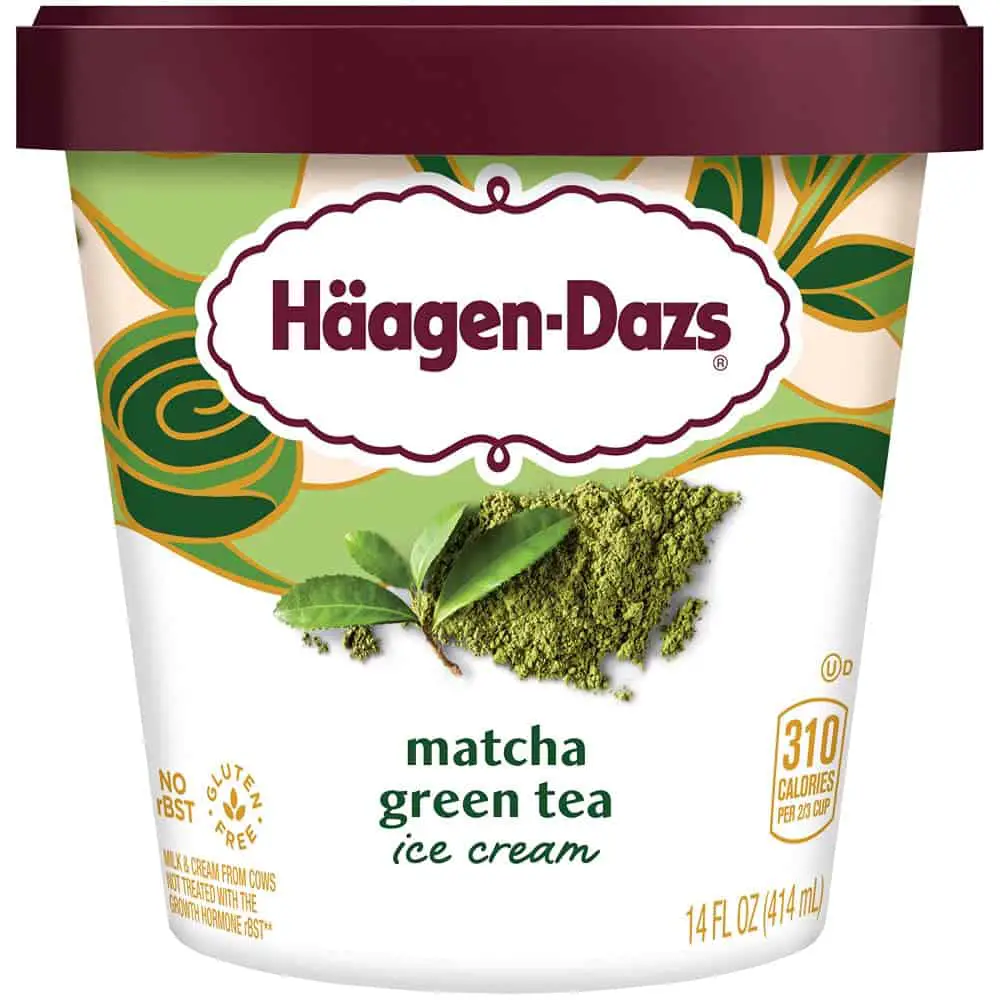
Tearrific
Tearrific has both matcha green tea and a ginger matcha ice cream flavors.
Their matcha green tea blends sweetness with earthy notes. Their ginger matcha adds ginger notes to the matcha green tea taste.
Their ice creams are made with all-natural ingredients and organic cane sugar.
FAQs
Is Matcha ice cream vegan?
Green tea ice cream is usually made with milk, so it is not vegan. However, there are vegan-friendly recipes that use non-dairy milk.
Is Matcha ice cream gluten-free?
You would think ice cream contains gluten due to its high sugar content.
However, pure sugar is gluten-free. Even though it’s a distant relative to wheat, barley, and rye, it does not contain the gluten element.
However, it is possible to add other products to matcha ice cream that contain gluten. Therefore, it’s best to follow a gluten-free recipe if you are trying to avoid gluten.
Is Matcha ice cream paleo?
Those on a strict paleo diet stick to eating foods that are only found naturally on the earth…and I’m pretty sure matcha ice cream would not qualify.
However, if you follow the right recipe, you can use all-natural products to make a paleo-friendly matcha ice cream. Substituting sugar with honey is a good first step.
Is Matcha ice cream Keto?
Matcha powder and matcha tea are keto friendly. Some types of matcha ice cream are also suitable for a keto diet.
There are certain ice cream recipes that don’t use dairy, eggs, and sugar, and those are considered keto-friendly.
Those following a keto diet eat foods that are low in sugar and carbs and high in healthy fats. Ice cream tends to be high in carbs and sugar, and it’s not considered keto.
However, there are low-carb, low-sugar recipes you can follow, including ones for matcha ice cream.
What is Mochi ice cream?
When you start exploring the world of Japanese ice cream, you will surely become familiar with ‘mochi ice cream’.
This is an ice cream bite surrounded by a ball of sweet rice dough. The ice cream is in the center of the mochi ball.
Not all mochi is ice cream. Instead, mochi is actually a general term for sweet rice cakes.
The dough is made from glutinous rice flour, sugar, and water. It can be filled with all sorts of fillings.
Mochi ice cream is different because of its texture and shape, but it is available in green tea and matcha flavor.
In Japanese culture, it is a portable way to eat ice cream, and it is also a sign of fortune.
While mochi ice cream is available in green tea and matcha flavors, it is also available in several other flavors.
It is important to understand that the two are not one and the same.
Does matcha green tea ice cream have dairy?
Yes, most matcha green tea ice cream recipes use dairy. However, there are some vegan recipes that use non-dairy milk instead.
Usually, the ice cream contains whole milk, egg yolks, heavy cream, and/or condensed milk. These ingredients give the ice cream its creamy texture and rich flavor.
What is tea-flavored ice cream?
Tea-flavored ice cream is made by steeping tea leaves in milk, which infuses the milk with the flavor of the tea. The milk is then used to make the ice cream.
The tea leaves are strained out before the mixture is churned in an ice cream maker.
Tea-flavored ice cream can be made with any type of tea, but green tea and matcha are two of the most popular kinds.
But tea-flavored ice cream and matcha green tea ice cream are not the same things.
Is culinary grade matcha good for you?
The antioxidants present in matcha tea are beneficial for your health. However, it is important to note that not all matcha is created equal.
Culinary grade matcha is lower quality than ceremonial grade and is not meant to be consumed on its own.
It is meant to be used as an ingredient in recipes, such as matcha green tea ice cream.
While culinary grade matcha is not as good for you as ceremonial grade, it can still be a healthy addition to your diet.
Culinary grade matcha is a good source of antioxidants, but it is not as potent as ceremonial grade. It is still a healthy addition to your diet, but it should not be consumed on its own.
Can you use culinary matcha for tea?
No, you should not use culinary matcha for tea. This is because the leaves are of a lower quality and are meant to be used as an ingredient, not consumed on their own.
Takeaway
Matcha green tea ice cream has established itself as one of the most popular flavors. Its rich and creamy taste is perfect for any matcha lover.
Be sure to check out one of the many brands that offer this delicious flavor. You won’t be disappointed!
You can also try matcha-flavored homemade ice cream with dairy and matcha powder.
Check out our new cookbook
Bitemybun's family recipes with complete meal planner and recipe guide.
Try it out for free with Kindle Unlimited:
Read for freeJoost Nusselder, the founder of Bite My Bun is a content marketer, dad and loves trying out new food with Japanese food at the heart of his passion, and together with his team he's been creating in-depth blog articles since 2016 to help loyal readers with recipes and cooking tips.
